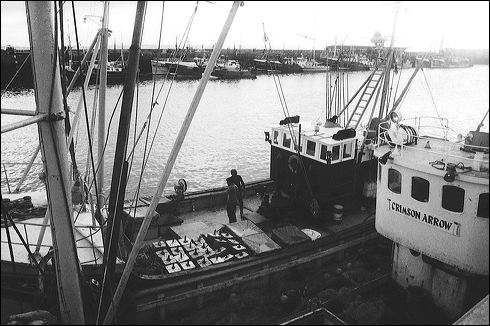"#driftnetban : Now NUTFA understands the tricky games they were thrown into: first friend then control. I know NUTFA were sincere and really tried to defend the smallest but Big NGO played with them. To understand driftnet ban, read again the sustainable fisheries trusts part of blue Charity Business summary [or how BINGOS control & command a fishery by using the good image of the smallest fishermen] http://www.peche-dev.org/IMG/pdf/121107_blue_charity_abstract_en-2.pdf .
BINGOs first pretend to be friend of smallest fishermen, then use them in the public opinion to kill the biggest, then control the smallest; here it is not through privatization, but only through regulation via EU under the table pressure, pretending the smallest carry IUU cases. Damanaki is for long a strong ally of PEW, and reversely."
Though one NUTFA member and small scale fisherman it seems is not so impressed:
@PecheFraiche Oh good, yet another self appointed consultant telling fishermen that they are naive. Don't be so patronising please.
Maybe Jerry and Yan should talk?
Ian Kinsey makes a very valid point in the discussion:
Ian Kinsey The majority of SSF are of a marginal nature , and demand a great deal of the vessel owner,s direct participation in the fishery. This kind of fishery is at the present time not the most attractive segment of the fishing industry for investment by proponents of privatisation.
The fisherman has let himself be played over the sideline, and into a roll as the "necessary evil" in justifying so many positions in and associated with the fishing industry. Collaboration seems to be the new mantra of many ENGOs and scientific groups, such as the GAP 2 and EDF. I am equally suspicious of both. Good fisheries management has many likenesses with good parenting - having the ability and foresight to lead, and nurture a collaborative environment to the benefit of the ecosystem.
Ian Kinsey makes a very valid point in the discussion:
Ian Kinsey The majority of SSF are of a marginal nature , and demand a great deal of the vessel owner,s direct participation in the fishery. This kind of fishery is at the present time not the most attractive segment of the fishing industry for investment by proponents of privatisation.
The fisherman has let himself be played over the sideline, and into a roll as the "necessary evil" in justifying so many positions in and associated with the fishing industry. Collaboration seems to be the new mantra of many ENGOs and scientific groups, such as the GAP 2 and EDF. I am equally suspicious of both. Good fisheries management has many likenesses with good parenting - having the ability and foresight to lead, and nurture a collaborative environment to the benefit of the ecosystem.






















